Menus
- Generation comparison
- The Honda Africa Twin hit like a bomb in 1988
- Idle speed hardly higher than a marine diesel
- BMW R 1200 GS can do everything better
- Even in series production it was good for the Dakar
- "I would go back to Dakar with that"
- Conclusion
- Model history of the GS
- Model history of the Africa Twin
- Herbert Schek, 83, off-road legend
- Eddy Hau, 64, rally and enduro icon
- Technical specifications
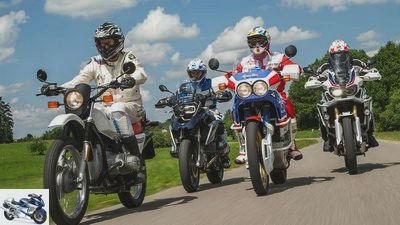
Arturo Rivas
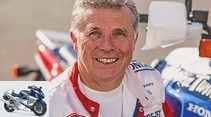
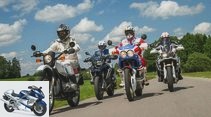
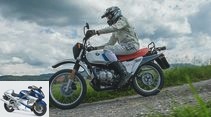
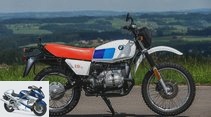
33 photos
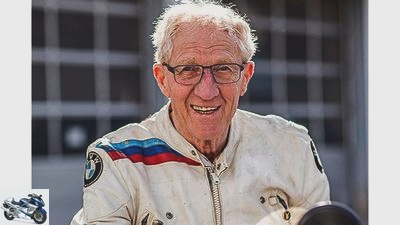
Arturo Rivas
1/33
Herbert Schek, 83, off-road legend: “The Dakar brought
the GS the breakthrough “.
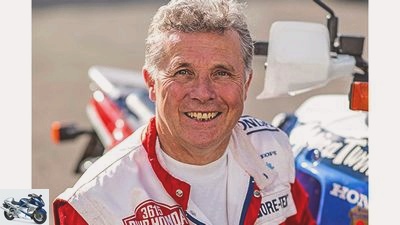
Arturo Rivas
2/33
Eddy Hau, 64, rally and enduro icon: “Would also go to Dakar with the new one”.
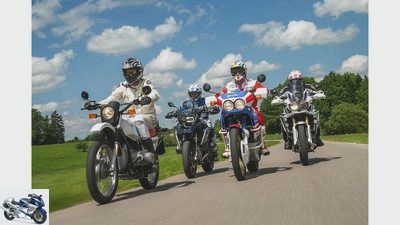
Arturo Rivas
3/33
The generation comparison: BMW R 80 G / S and R 1200 GS and Honda XRV 650 Africa Twin and CRF 1000 L Africa Twin.
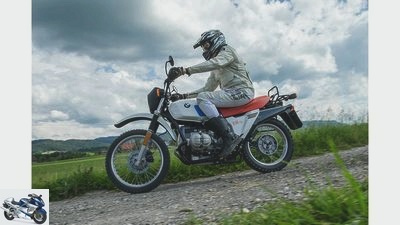
Arturo Rivas
4/33
The starting shot: The first GS laid the foundation for the travel enduro segment in 1980 – a legend.
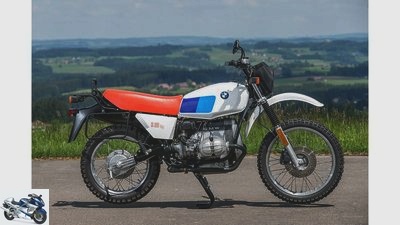
Arturo Rivas
5/33
BMW R 80 G / S.
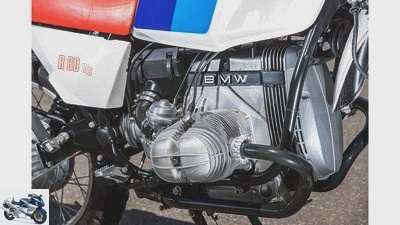
Arturo Rivas
6/33
BMW R 80 G / S.
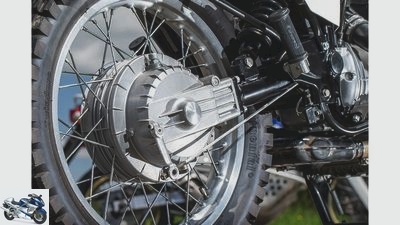
Arturo Rivas
7/33
BMW R 80 G / S.
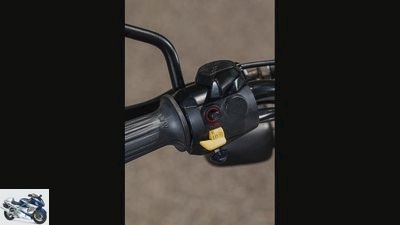
Arturo Rivas
8/33
BMW R 80 G / S.
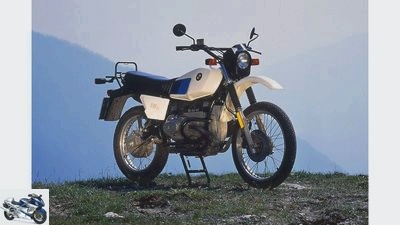
9/33
Model history – R 80 G / S (1980). The R 80 G / S is presented. Technical highlight: the single-sided swing arm. The G / S has 50 hp and weighs 196 kilograms.
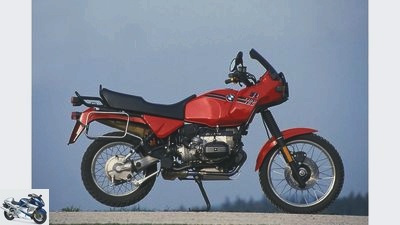
Frank Herzog
10/33
R 100 GS (1987). The engine is increased to 980 cm³ and makes 60 hp. The new Paralever swing arm minimizes cardan reactions.
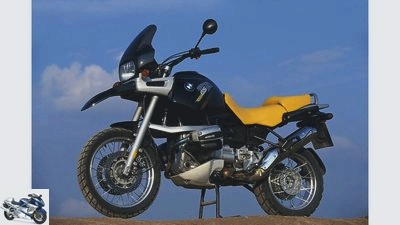
Frank Herzog
11/33
R 100 GS (1994). The GS receives the Telelever front wheel suspension and the four-valve boxer (1085 cm³, 80 PS). ABS costs 2000 marks extra.
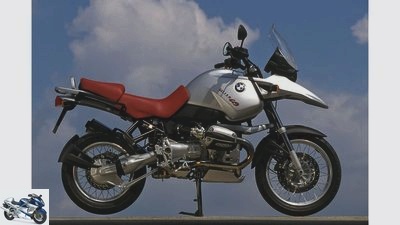
Hanselmann
12/33
R 1150 GS (1999). The displacement increases to 1130 cm³, the peak power to 85 hp. A new transmission (for the first time with six gears) is installed.
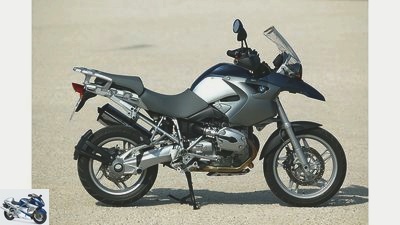
www.factstudio.de
13/33
R 1200 GS (2004). The new boxer now has a displacement of 1170 cc and 98 hp. The GS becomes 22 kilograms lighter (242 kg).

www.factstudio.de
14/33
R 1200 GS (2004).
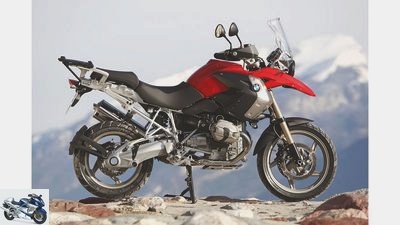
15/33
R 1200 GS (2010). The GS takes over the valve train of the HP2 models (two camshafts, radial valves). Peak power: 110 hp.
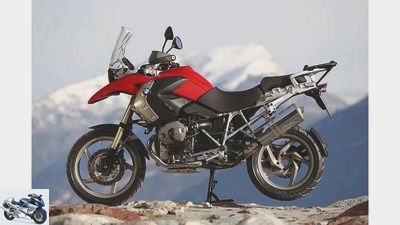
16/33
R 1200 GS (2010).
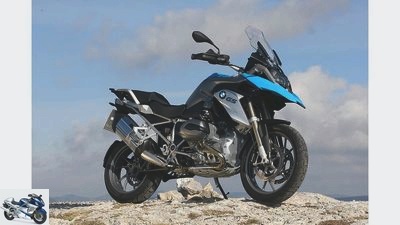
17/33
R 1200 GS (2013). The GS technology is completely turned inside out (new frame, water cooling, cardan on the left). It now has 125 hp.
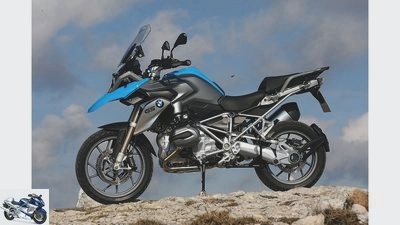
18/33
R 1200 GS (2013).
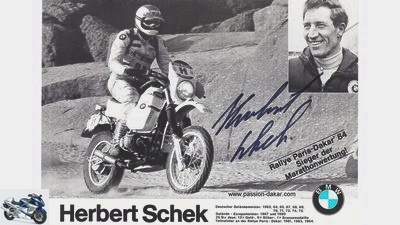
BMW
19/33
Herbert Schek has been in the saddle of off-road machines for 65 years.
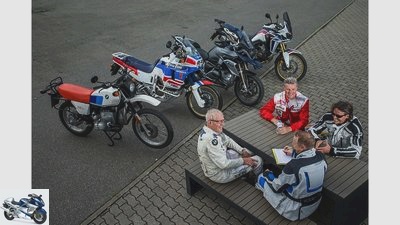
Arturo Rivas
20/33
Time leap: almost four decades of travel enduro history over five meters. Enough material to philosophize about until the next model change.
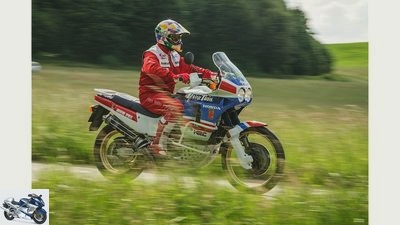
Arturo Rivas
21/33
Avant-garde: Even after 28 years – the look of the Africa Twin from 1988 still looks modern today.
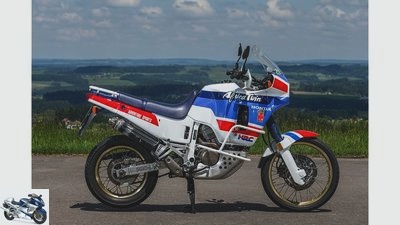
Arturo Rivas
22/33
Honda XRV 650 Africa Twin.
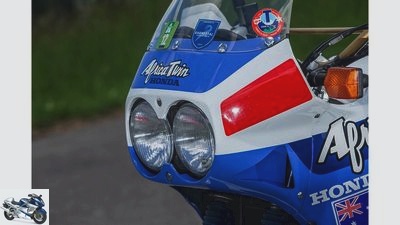
Arturo Rivas
23/33
Honda XRV 650 Africa Twin.
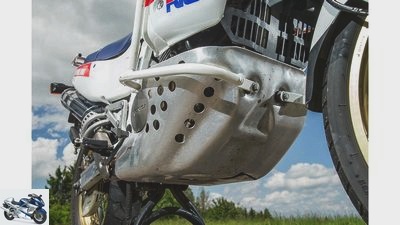
Arturo Rivas
24/33
Honda XRV 650 Africa Twin.
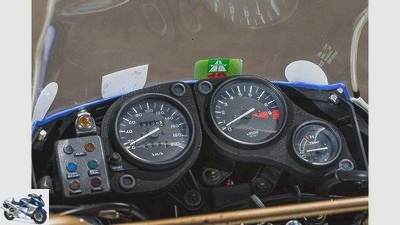
Arturo Rivas
25/33
Honda XRV 650 Africa Twin.
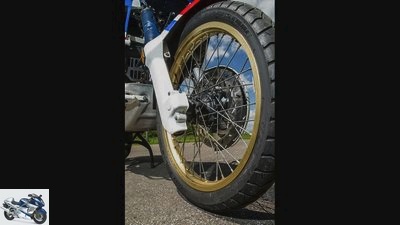
Arturo Rivas
26/33
Honda XRV 650 Africa Twin.
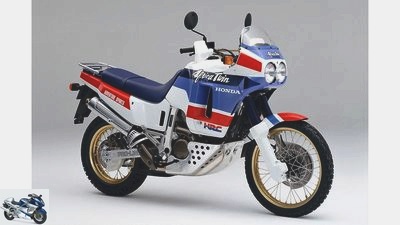
Honda
27/33
Manageable – model history of the Africa Twin: XRV 650 Africa Twin (1988). The Africa Twin is being built on the basis of the Transalp. The displacement of the 583-Transalp-V2 increases to 647 cm³ for the new one.
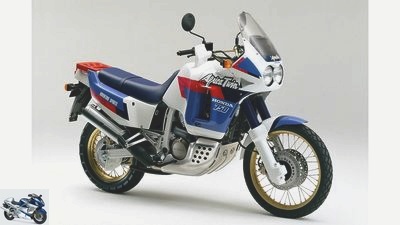
Honda
28/33
XRV 750 Africa Twin (1990). The displacement climbed to 742 cm³, but the power remained throttled to 50 hp. The weight increases by 17 to 237 kilograms.
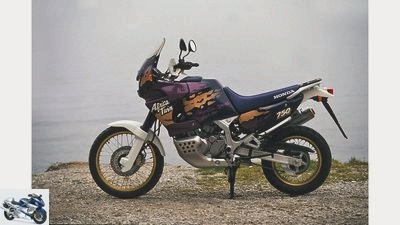
Stefan Wolf
29/33
XRV 750 Africa Twin (1993-2003). The frame, exhaust and fairing are largely new and save three kilos. The peak power is now 60 hp.

Honda
30/33
Physical fitness and iron discipline also distinguished the 64-year-old during his time in enduro sport (seven German championship and four European championship titles) and motocross (one German championship title).
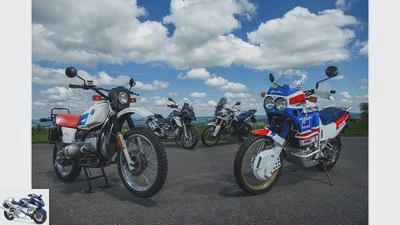
Arturo Rivas
31/33
The generation comparison: BMW R 80 G / S and R 1200 GS and Honda XRV 650 Africa Twin and CRF 1000 L Africa Twin.
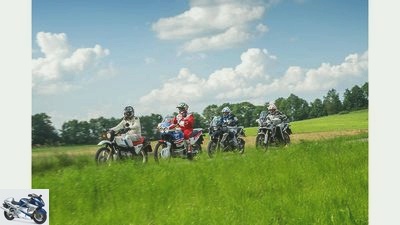
Arturo Rivas
32/33
The generation comparison: BMW R 80 G / S and R 1200 GS and Honda XRV 650 Africa Twin and CRF 1000 L Africa Twin.
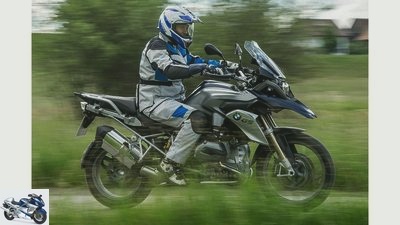
Arturo Rivas
33/33
The top dog: The GS (above) is the boss in the travel enduro ring. Thanks to high-tech – not in spite of it.
BMW Boxer GS and Honda Africa Twin
Generation comparison
The BMW R 80 G / S and the Honda Africa Twin were the travel enduro icons of the 1980s. MOTORRAD went looking for clues. Also there: the German rally stars of the time, Eddy Hau and Herbert Schek as well as the new Honda Africa Twin and the BMW R 1200 GS.
Is the wrong calendar hanging on the wall here? Herbert Schek and Eddy Hau stroll flatly towards the machines, their helmets dangling in their hands, their off-road clothes glow against the gray walls of the workshop. Your robe is still in its original condition. The white leather jacket with the blue “Schek” leather letters on the back from 1984 as well as the fire-red team clothing of the Africa Twin pilots of the Dakar 1991 by Eddy. But nobody has turned back the decades. The two have thrown themselves into their former shell as prominent companions on a journey through time. A journey through time on which the currently most popular travel enduros celebrate a reunion with their ancestors: the BMW R. 1200 GS and the Honda CRF 1000 L Africa Twin.
Buy complete article
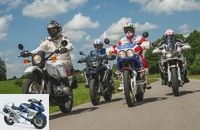
BMW Boxer GS and Honda Africa Twin
Generation comparison
R 80 G / S in 1980 standing on his head, Herbert Schek could only smile mildly. He had long known about the dormant potential of the boxer. A decade earlier, the man from the Allgau had already converted the R 75/5, which was hardly suitable for off-road use, and chauffeured it to three Enduro DM titles in a row. G / S – the abbreviation for terrain and road – was taken seriously by the Bavarians when they launched, not least because of the off-road successes of Schek and later some other BMW employees. And that’s how it still stands today, the original GS, restored to new condition by the two-valve boxer specialist Siebenrock (www.siebenrock.com). The single-sided swing arm, which was installed for the first time in the BMW GS, made it possible to nestle the raised exhaust pipe close to the rear end for driving gymnastics exercises; a 21-inch front wheel was supposed to guide the front precisely on gravel passes or in the Sahara sand. But it did, then as now, especially on the country roads and highways of Central Europe. Nevertheless: With the G / S, the segment of universal two-cylinder travel enduro bikes was born.
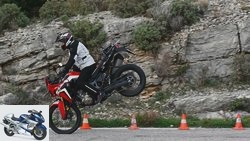
Enduro
Honda Africa Twin in the top test
The strenght is to be found in serenity
read more
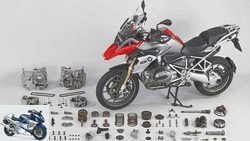
Enduro
Endurance test final balance of the BMW R 1200 GS
Storage fever at the bestseller
read more
The Honda Africa Twin hit like a bomb in 1988
The Japanese manufacturer caught the BMW advance cold. Honda countered with the little-noticed XLV 750 R only in 1983, then followed suit with the Transalp. The path to success was only paved by the Paris – Dakar rally, which electrified the masses at the time. After the victories of the Frenchman Cyril Neveu on the factory Honda NXR 750, affectionately dubbed Queen of Africa, the Africa Twin hit like a bomb in 1988 – even if its technology had hardly anything to do with the factory bike, but was directly derived from the brave Transalp . A three millimeter larger bore lifted the displacement of the V2 from 583 cm³ to 647 cm³, higher quality spring elements gave the chassis more reserves, but their appearance was decisive for the enormous attention. A stylish rally dress, also only available in the colors of the Honda Racing Corporation (HRC). And this coloring shines on the machine of MOTORRAD reader Andreas Jaus, even after 28 years and 112,000 kilometers of everyday use, almost as it was then.
The charm of eternal youth also seems to attract the two star guests. The duo headed straight for the well-preserved youngtimers and straightened up on the bench. “Scho mol guat, oin e-starter”, Herbert mumbles to himself in the Allgau dialect. Electric starters were only available as an accessory for the first GS models for an additional 150 marks. In general: what is not there will not break. On the right armature the starter button, on the left the turn signal, light switch, horn and choke. In between a bull-eyed speedometer with a few shyly glowing warning lights. Enough. The rest? Narrow – despite the 20 liter tank. Low – because the pillion seat and luggage rack continue the straight lines of the 850 millimeter high and slim driver’s seat.
Idle speed hardly higher than a marine diesel
Eddy grins in amusement: “Just like before.” The sportsman originally tackled the Dakar in 1991 with the Honda Africa Twin in the marathon class reserved for near-series machines. Only two additional rear tanks with eight liters each, revised spring elements and the single disc brake at the front set the Africa Twin apart from the production version. And yet too much. The 750 cm³ standard model was delivered with two brake discs at the front. All Africa Twin drivers were therefore thrown out of the marathon classification during the rally. Hau’s 19th place in the overall classification would have resulted in second place in the marathon class. Too bad. And yet yesterday’s news. In contrast to the feeling on the Honda Africa Twin. The foam, which has sagged a bit over the years, or the play in the levers may remind you of the yearlings on the back of the Japanese woman, but not her ergonomics. There the Honda with its slim fairing, the straight handlebars mounted quite far forward had already arrived in the modern age. And the two unexcited round instruments still shame every digital mouse cinema today.
Herbert urges. He’s been doing this for 83 years. And the ever-busy man swings through the pre-alpine hill country around Wangen on two wheels for almost as long. The BMW R 80 G / S is not only transformed into a minibike under the 1.94 meter tall man. The visual difference to the gigantic current BMW R 1200 GS could hardly be greater. Probably not the driving experience either. Rubber cow, elevator – the G / S shows what the mockers of that time patted each other on the thighs about. A short burst of gas before the start – the longitudinal crankshaft tilts the Bavarian to the right. Apply gas when accelerating – the cardan lifts the hindquarters. Throttle closed and the stern collapses again. A courageous grip on the front brake – the single disc wriggles on the delicate 36 mm fork – pulls the senior citizen to the left. The BMW R 1200 GS is alive. Probably for this reason, then as now, hardly anyone felt underpowered with the 50 hp two-valve engine. But on the contrary. With an idle speed barely higher than a marine diesel and a power output as tender as hand-warm chocolate, the Flat Twin is still flattering today. No comparison to the rough running singles from Yamaha XT and Co., on which the adventure generation from Recklinghausen to Tamanrasset – or at least to the Bergisches Land – rumbled at that time.
BMW R 1200 GS can do everything better
However, the original GS has much, much less to do with its current version. Not a single screw that hasn’t been turned over the past 36 years. Not a technical trick that the GS was not fine-tuned with every model change. Paralever, Telelever, ABS, ASC, Ride-by-Wire or ESA – the list of ingredients reads like the leaflet on a DVD player at Media Markt. And since the 2013 model, not even the crankshaft of the – now water-cooled and vertically flowed through – boxer has turned in the same direction as before. But the end justifies the means. The new one accelerates, brakes, springs, dampens, steers, sprints, yes, everything can do better. Much, much better. But the BMW R 1200 GS has nothing to do with the BMW R 80 G / S. Nothing at all anymore.
Maybe that’s why Herbert waves it away. Driver change? No thanks. “Koasch sit, stay.” Too many buttons, too big dimensions and too many pounds. His self-built R 75/5 Enduro from 1973 weighed 125 kilograms. Almost exactly half of the current BMW R 1200 GS. The warhorse only uses the 800 G / S for the presumably not at all senior-friendly trips with his motorcycle friends.
Even in series production it was good for the Dakar
Eddy Hau still can’t get out of raving about his former crush. “The Africa Twin not only feels like a modern motorcycle, it drives like that too,” the 64-year-old rubs his chin in amazement. “At the time I wasn’t really aware that this motorcycle was actually suitable for the Dakar in series production,” says Hau, posthumously, ennobling the Honda Africa Twin. In fact, the Twin still throws itself in the chest today, steers neutrally, brakes properly, remains stable on course, cleverly conceals its 220 kilos live weight (BMW: 196 kg) and simply does not show its age in the least. The 53 hp three-valve engine (two intake valves, one exhaust valve per cylinder) even spits out the somewhat inferior performance as wide-awake as the boxer in the original G / S does not even dare to dream of. To save the Bavarian’s honor: In the developmental Sturm und Drang phases of that time, eight years of age difference meant a generation change. In fact, in 1988 the Honda Africa Twin did not fight the BMW R 80 G / S, but rather the BMW R 100 GS (980 cm³ / 60 PS) presented in 1987.
So be it. The elaborately configured Vau Zwo of the first Honda Africa Twin with a 52 degree cylinder angle and 76 degree crank pin offset is no longer available in the new one. In it, a – cheaper – parallel twin with 270 degree crank pin offset imitates the character and sound of a V2. But in contrast to the GS, which moved further away from its origins with each model, the Africa Twin still carries its DNA within it, which is already documented in the technical data.
"I would go back to Dakar with that"
In terms of wheelbase, steering angle and caster, the geometries are almost exactly the same to the nearest millimeter or degree. Even the 21-inch front wheel, which has become unusual in current travel enduros, rotates between the fork legs. And the model planners also preserved the spirit of the original twin. Keep it simple, just keep it simple. ABS and traction control – that’s enough. No ride-by-wire, no driving modes, no electronic chassis. What is not there cannot break – as with the original G / S. Probably one of the reasons for the success of the new Honda CRF 1000 L Africa Twin. Not only Eddy feels as at home on it in seconds as a Bavarian in a beer garden, misses no bit, no byte and no adjustment button. The knee joint is a little slimmer, the bench a bit more comfortable, the handling is easier thanks to the successful centralization of the masses. The new one absorbs the additional 13 kilograms compared to the old one without leaving any residue. With so much sheen, you can generously forgive her the faux pas with the front wheel tire (Dunlop Trailmax D 610), which is wobbly at a greater angle. And of course you also enjoy the additional pressure with which the 95 hp 1000 series almost halves the acceleration times of its predecessor. But she doesn’t even hit the plaster, she does everything in her reserved, effortless way. Keep it simple. “With that I would go to Dakar again. As far as I’m concerned, today, ”jokes Eddy – and thus sums up the character of the Africa Twin precisely.
After all, this is exactly what demonstrates the completely different development directions that the two travel enduros have taken. While the Honda CRF 1000 L Africa Twin continues on the track of the previous models, the GS basically reinvented itself in its uninterrupted evolution. You can be happy with both concepts. The GS has been proving this for 36 years – and the Africa Twin since this season. Few of them will go to Dakar with them. And Eddy and Herbert? Better not give them the idea anymore.
Conclusion
If two do the same thing, it is still far from the same – the winged sentence hits exactly the evolution of the GS and Africa Twin. While the BMW has developed from the shirt-sleeved boxer of the early years to a highly technical all-rounder, the new Honda Africa Twin consciously preserves the spirit of the original twin. The good news is that both paths are currently leading to success.
Model history of the GS
- 1980 – BMW R 80 G / S: The R 80 G / S is presented. Technical highlight: the single-sided swing arm. The G / S has 50 hp and weighs 196 kilograms.
- 1987 – BMW R 100 GS: The engine is increased to 980 cm³ and makes 60 hp. The new Paralever swing arm minimizes cardan reactions.
- 1994 – BMW R 100 GS: The GS receives the Telelever front wheel suspension and the four-valve boxer (1085 cm³, 80 PS). ABS costs 2000 marks extra.
- 1999 – BMW R 1150 GS: The displacement increases to 1130 cm³, the peak power to 85 hp. A new transmission (for the first time with six gears) is installed.
- 2004 – BMW R 1200 GS: The new boxer now has 1170 cc and 98 hp. The GS becomes 22 kilograms lighter (242 kg).
- 2010 – BMW R 1200 GS: The GS takes over the valve train of the HP2 models (two camshafts, radial valves). Peak power: 110 hp.
- 2013 – BMW R 1200 GS: The GS technology is completely turned inside out (new frame, water cooling, cardan on the left). It now has 125 hp.
Model history of the Africa Twin
- 1988 – Honda XRV 650 Africa Twin: The Africa Twin is built on the basis of the Transalp. The displacement of the 583-Transalp-V2 increases to 647 cm³ for the new one.
- 1990 – Honda XRV 750 Africa Twin: The displacement climbs to 742 cm³, but the power remains throttled to 50 hp. The weight increases by 17 to 237 kilograms.
- 1993-2003 – Honda XRV 750 Africa Twin: frame, exhaust and fairing are largely new and save three kilos. The peak power is now 60 hp.
Herbert Schek, 83, off-road legend
Arturo Rivas
“The Dakar brought the breakthrough for the GS”
Exactly 65 years – that’s how long Herbert Schek has been in the saddle of off-road machines. Since 1951 in off-road sport events (eleven DM and two European championship titles, 25 six days), since 1981 in the Dakar rally, since 1993 in classic enduros. Above all, the desert hunt had done it to him. The warhorse already counted 49 Lenze at its Dakar premiere, not only doing brilliantly as a driver (winner of the marathon class 1984), but also as a technician. The BMW of the 1984 Dakar winner, Gaston Rahier, was assembled in Schek’s workshop in Wangen im Allgau.
Eddy Hau, 64, rally and enduro icon
Arturo Rivas
“Would also go to Dakar with the new Honda Africa Twin”
Should motorcycling get you really young, Eddy Hau would be proof of that. Physical fitness and iron discipline also distinguished the 64-year-old during his time in enduro sport (seven German championship and four European championship titles) and motocross (one German championship title). The Bavarian, who lives in Sauerlach near Munich, lived up to his professional standards in his career in rallying. As a privateer, he clinched victory in the marathon class on a BMW in 1988. The Franconian native marked the end of his motorsport career with a start on a Honda Africa Twin at the Dakar in 1991. Hau took 19th place on the almost standard machine.
Technical specifications
Here you can see an extract of the technical data. If you would like the complete measurement values determined by us, including all consumption, torque and acceleration values, you can buy the article as a PDF for download.
Related articles
-
BMW R 1200 GS Rallye and Honda Africa Twin in comparison test
factstudio.de 19 pictures fact 1/19 With the “Rallye” -GS BMW underlines the “Enduro” behind the “Reise”. Honda did this with the Africa Twin from …
-
markus-jahn.com 21 pictures markus-jahn.com 1/21 The first impressions of the Honda Africa Twin at its presentation were very promising. But now…
-
Honda Africa Twin, KTM 1050 Adventure and Suzuki V-Strom 1000
markus-jahn.com 33 photos archive 1/33 Power on the crankshaft. Measurements on the Dynojet roller test stand 250, corrected according to 95/1 / EG,…
-
Archive pictures Honda XRV 650 Africa Twin and the driving report from MOTORRAD 09-1988
duke 17th photos duke 1/17 The more bumpy the track becomes, the more clearly the Honda can set itself apart from competitors like the BMW R 80 GS. duke…
-
Africa Twin model presentation
Honda model presentation Africa Twin Is that one … … or that one? Given the very different appearances of the new Honda Africa Twin, a good …
-
The Honda XRV 650 Africa Twin in an individual test
fact 13 pictures fact 1/13 On the move with the Honda XRV 650 Africa Twin. fact 2/13 Optically a motorcycle dream – the Honda XRV 650 Africa Twin. fact 3/13 …
-
Driving report Honda CRF 1000 L Africa Twin (part 1)
Honda 13 photos ULA SERRA PRATS 1/13 Honda Africa Twin. 2/13 270 degree crank pin offset, long, continuous shaft with two balance weights in front of the…
-
Honda CRF 1100 L Africa Twin (2020) in the driving report
Motorcycle fair in Milan EICMA 2019 Presented by Honda 14th photos Honda 1/14 The base model Honda CRF 1100 L Africa Twin comes exclusively with the…
-
Honda Africa Twin in the top test
markus-jahn.com 21st photos markus-jahn.com 1/21 The first impressions of the Honda Africa Twin when it was presented were promising. But now it applies….
-
790cc Honda Africa Twin: is Honda working on a small CRF?
New items for 2021 Motorcycle innovations 2021 Honda. Honda Africa Twin with 790 cc Honda is working on a small CRF? Rumor has it that Honda is working…